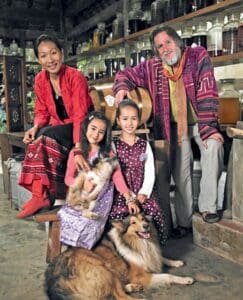In the early ’90s, a series of Kadsura Dragon™ Vine expeditions into the wilds of montane and subtropical China was made by Jerome Black, of Oregon, focusing his work in Guizhou, Hubei, Yunnan, Guangxi, and with indigenous hill tribes on the borders of Myanmar, Laos, and Vietnam. After being arrested in China in 1991 and again in 1992, for his research in remote tribal regions, Black teamed up with Katy Warren of ‘Green Gold Ranch’ in the late 1990s to grow the plants near Chico California. Warren soon brought in Jimmy and Oscar Hernandez, who were founders, President, and V.P. respectively of the mission-driven “Melissa’s World Variety Produce” of Los Angeles California.

In 1999, new plant material for the Kadsura Dragon™ Vine was brought in through another expedition. This time sponsored by Warren and lead by Black, with Black getting arrested a third time 80 miles S.E. of Jinhong China on the border near Myanmar. Black was hauled into jail with seeds and hundreds of cuttings, and put under arrest in Jinhong. Dr. Josef Margraf of the German NGO working in the area negotiated Black’s release with significant leverage and finances through his German NGO.
Soon after Black’s release more Kadsura Dragon™ Vine clones of the ancient cultivars secretly made their way from to California, Oregon, and Costa Rica. It was reported that Black, using multiple passports over seven years, had stashed away hundreds of cuttings and seeds somewhere between Vietnam and Hong Kong before his arrest.
During those years, a journal of fruit exploration was published for circulation in 1994, and 30,000 copies with black and white images of the Kadsura Dragon™ Vine were sent to prominent US Botanical gardens, farmers, NAFEX members, and curators of American nurseries. The journal propositioned these experts to identify and name this enigmatic fruit. Most guessed it to be a species of Annona or Pandanus fruit, which it resembles.
But the Kadsura Gozillaberry continued to remain a fruit of mystery in the U.S., relegated to the researchers in China who were diligently working for its ultimate release to Chinese farmers.
In 2014, an image of the iconic berry was put online by another American rare fruit explorer who traversed Laos and northern Thailand and proposed it was a type of Annona species.